The Emerald Isle is brilliantly green, with pastures dazzling during fleeting moments of sunshine. We drove throughout multiple counties admiring the farms, castles, wildflowers, trees, and rolling hills. It was not all sunshine and rainbows though. Even in June, the weather was wet, windy, and chilly. This sign in Dublin really resonated with me:

But our month-long stay in Ireland was still wonderful. We caught up with old friends, discovered small towns, learned so much history, and enjoyed great food. Ireland is a must-see destination — just make sure to bring a raincoat.
OPW Heritage Cards
Many of Ireland’s great landmarks are operated and maintained by the national Office of Public Works (OPW). They sell a one-year pass for adults for just 40 euros per adult (so around $90 USD for the both of us). This compares favorably to the United States, which offers a pass for $80 USD that can cover four people. Both are a better value than the United Kingdom’s National Trust pass, which is 115 pounds (around $150 USD) for two adults for 14 days.
Armed with our Heritage Cards, we set out to explore Ireland’s history! (Unless noted, all sites below are fully included with the OPW Heritage Cards, including the tours!)
Kilkenny
Our first few nights were spent in a cozy Airbnb in Kilmacow, which is located in County Kilkenny. We used this as our base to explore nearby sights.

Our first outing was to the medieval village and castle in the town of Kilkenny. After arriving we immediately noticed why this city is so popular with tourists. It was so cute! Flower-lined pedestrian bridges crossed the river, the looming castle perched at the edge of town. The rest of downtown was filled with churches and pubs.
Kilkenny Castle tour

We took a tour with an engaging guide. Constructed in 1260, and lavishly restored by the OPW, the interior was a beautiful display. We learned a great deal about the Butler family and their role in the Norman conquest of Ireland.
Beer
After a full afternoon of sightseeing a refreshing beer at Smithwick’s hit the spot. Though the old brewery no longer produces beer, tourists can purchase a tour of the “Experience” (not part of the OPW) or just enjoy the patio (which is what we did!). We enjoyed a Kilkenny draft, which like Smithwick’s is a red ale, but with a nitro-pour like Guinness.
That felt like a full day so we went back “home” to relax. The following day we got an early start to make a long drive out to County Cork.
County Cork
We first stopped in the small seaside village of Ardmore in County Waterford. We hoped to grab a pastry and a coffee but 9 AM proved to be too early for this town. So we continued on through the gorgeous scenery. At one point we rounded a corner and spotted JJ’s Truck Stop, an “American style diner” in a double wide trailer. A greasy spoon was just the thing in the moment! While it may not have been a truly authentic American experience, we appreciated the espresso machine and we shared a sausage breakfast sandwich with chips (i.e., fries).
Charles Fort
Then we continued on to County Cork and Charles Fort. Built in the 1600’s this star fort was in use up until the Irish Civil War, when Irish anti-treaty forces abandoned the fort and set it ablaze. So it is currently in ruins but it has only been ruined for 100 years! The remaining walls and structures are well-preserved and the seaside views are great.

Kinsale
The town of Kinsale has become a seafood lover’s paradise, with choices ranging from traditional to fancy. After listening to a Rick Steves podcast on Irish cuisine, we went to Fishy Fish for lunch. It was a tasty dining experience, with the rich sauces complimenting the fresh seafood. Kinsale is worth a stop for a meal, and to take a walk around the harbor to work off the calories!

Anne’s Grove
The Heritage Ireland site does a great job of showing what is covered by the OPW Heritage Card, as well as the hours of operation and any current closures. There is also an online map for easier navigation, and they also provide a paper map at any of their sites.
We were close to Anne’s Grove and so stopped by this recently-opened estate garden for a self-guided tour. The home and property date to the 1600’s and have been used as a movie set. We noticed it in The Wind That Shakes The Barley. If you haven’t seen that movie, definitely add it to your watch list! (Thanks Barry for the recommendation.)
Given to the OPW in 2015, the property is still being restored. There is no access to the house, but there are winding trails through the landscape, and gardens to enjoy. There is an extensive collection of plants from around the world that were collected by the previous owners.

It was raining and no one else was around so we enjoyed a brief meander through the walled garden and along the river’s edge. The gardeners were hard at work and were happy to talk about the plants on display.
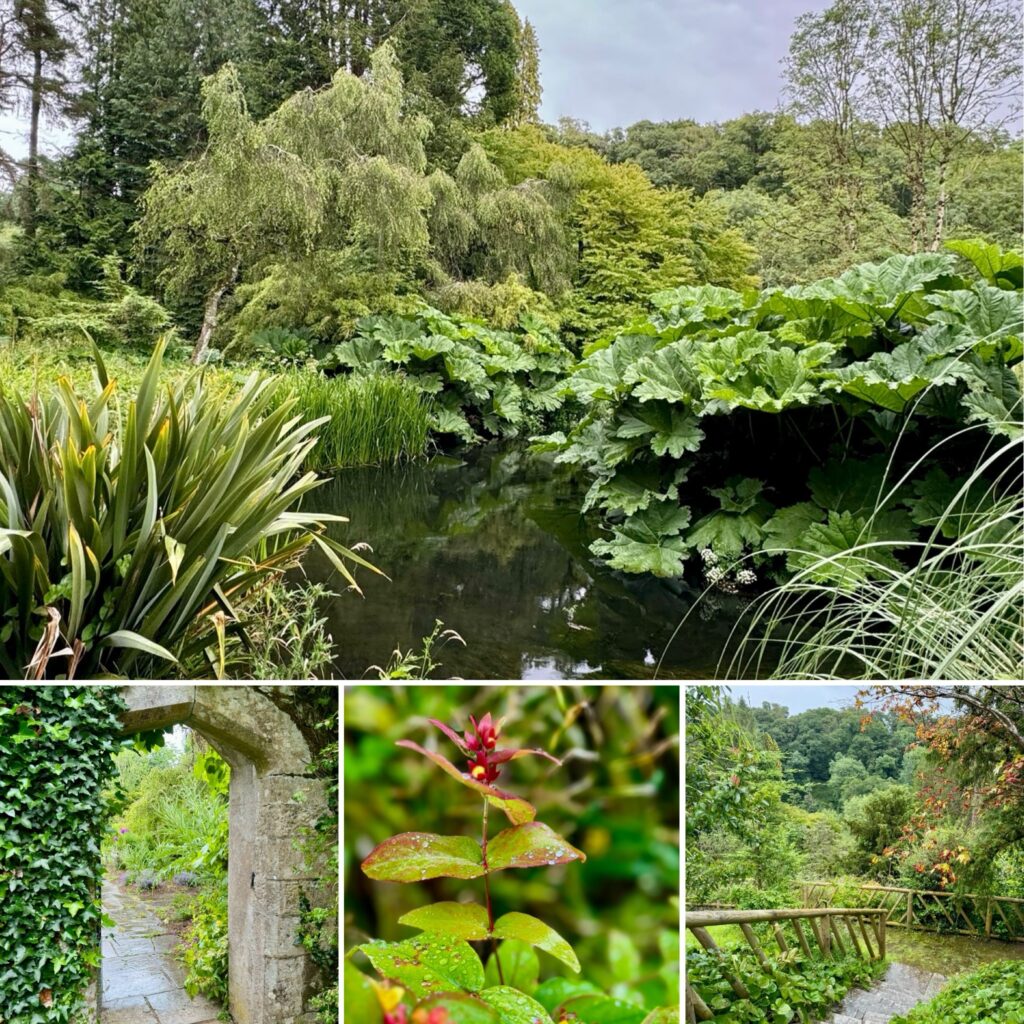
County Wexford
We moved to our next home where we met our companions and roommates: Lou, Muusli, Barley, and Heidi. What a fun bunch! We relaxed on the Irish homestead and played outside as much as possible when the sun peeked out. Both Lou and I were hoping for sunnier weather. It is Ireland after all so we made do and everyone was happy.

Most of the time was spent caring and socializing with the animals but we popped out to a few places every couple of days. (Ireland is filled with amazing cultural spots all over but we prioritized the sites included with our OPW membership.)

JFK Arboretum
Just down the road from the cottage lies a gorgeous arboretum honoring John F. Kennedy. Right before his death he had visited Ireland, and the Kennedy family comes from County Wexford.

Today visitors can walk through 600 acres of well-manicured parkland, or even picnic and enjoy the nature. At the visitor center, one exhibit is on the former president and his family. The other exhibit deals with trees in Ireland, a country that has been largely deforested.
Across the street is the Slieve Coillte hill, a viewpoint that offers a 360-degree view of the Irish countryside, and the opportunity to see six different counties (if the weather cooperates). It was clear when we were there, and we could see miles of stone fences cross-crossing the green hills. This Instagram reel includes the panorama from this viewpoint.
Tintern Abbey

Related to the larger Tintern Abbey in Wales, this monastery dates to around 1200 AD. With numerous changes over the years, it was eventually used as the living quarters for a wealthy estate. Historical exhibits detail some of the prior construction and demolition at the site. There is also a lovely walled garden surrounded by acres of walking and biking trails that extend to the coast.
Coastal Towns
We drove out to the coast and saw the seaside town of Kilmore Quay and Hook Lighthouse. Kilmore Quay is a cute beach town with lots of fish shacks offering seafood. We stopped for a crab roll and an ice cream sundae. The crab was fresh and delicious. The ice cream, like most we found in Ireland and the UK, was soft serve, which they call “whipped” ice cream. This was a surprise after having so much hand-scooped gelato in Italy. But although the whipped ice cream comes from a machine, it hit the spot for us. It was nice to stretch our legs and gaze out to the Saltee Islands.
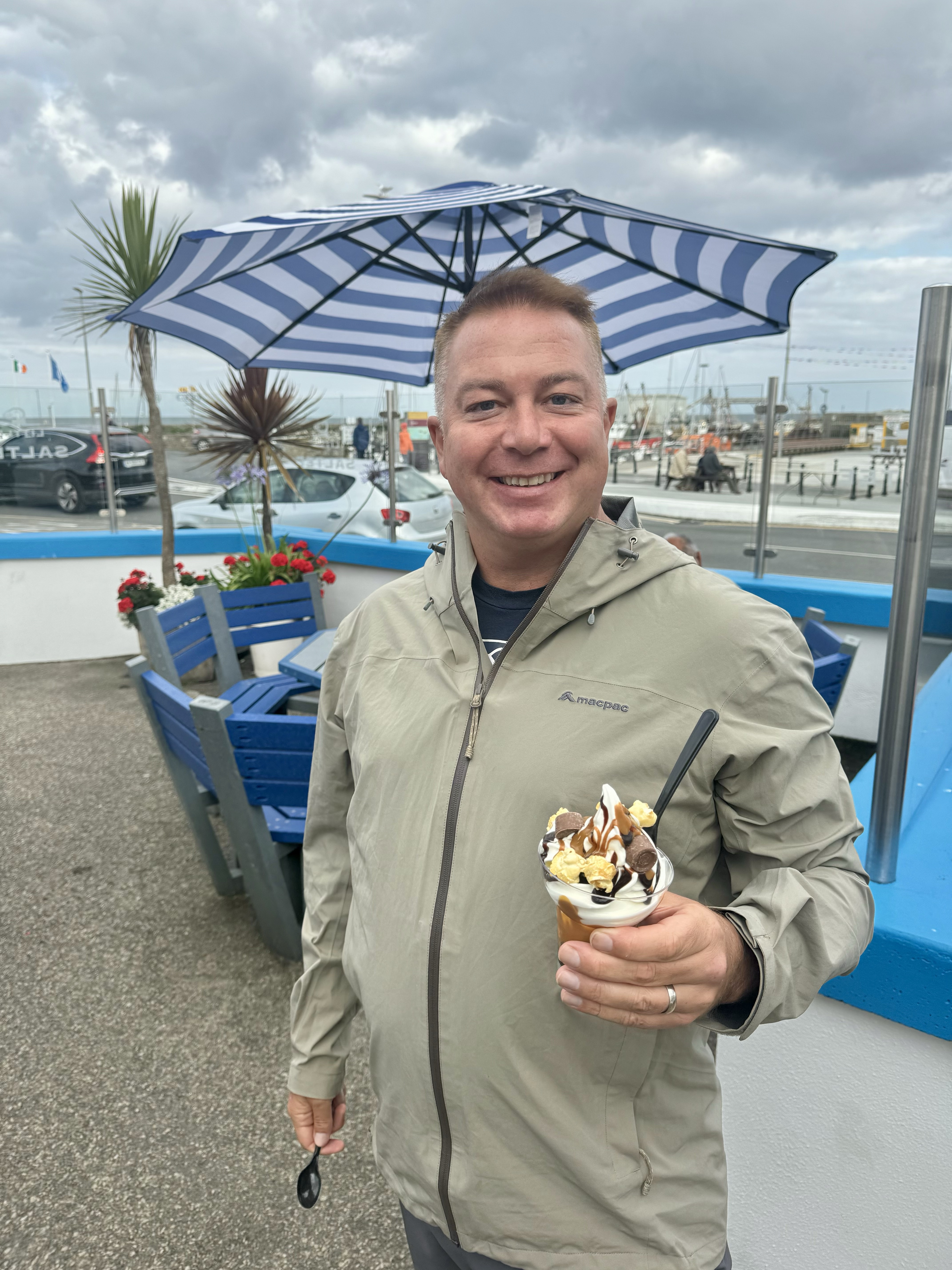
According to the sign, Hook Lighthouse is the oldest still-operating lighthouse in the world, although the internet says this title belongs to the Tower of Hercules in Spain. Built in the 1200’s, it is a thick-walled feat of medieval engineering. The grounds and visitor center are free to enjoy. Visitors can pay for a tour (not included with the Heritage Card) which includes a climb up the narrow stairwell inside. We declined but enjoyed the salty sea air. It rained while we were there so we did not get much of a walk in.

The entire Hook Peninsula is scenic, and there are many touristy beach towns and things to see while driving around the area, including the towns of Duncannon and Fethard.
Cooking at Home
One of the highlights for us was cooking in a real kitchen. We rarely see an Airbnb kitchen set up for making great meals. This housesit offered an air fryer and the Irish grocery stores offered high-quality products at affordable prices! We especially liked that Tesco had an aisle filled with Irish products, making it easy for us to snatch up cheeses, lamb, chicken, and other local fare.
We wrapped up housesitting on Corey’s birthday and drove to Hollywood for a four-night stay. Yes, there is a Hollywood in Ireland!
Hollywood, County Wicklow
Hollywood is a small village with a lot of fame. The St. Kevin’s Way trail starts from there (and leads to Glendalough, which we visit below). Possibly (and very indirectly) it may have been the namesake for the California town, and there have been several movies filmed in that area of Ireland.
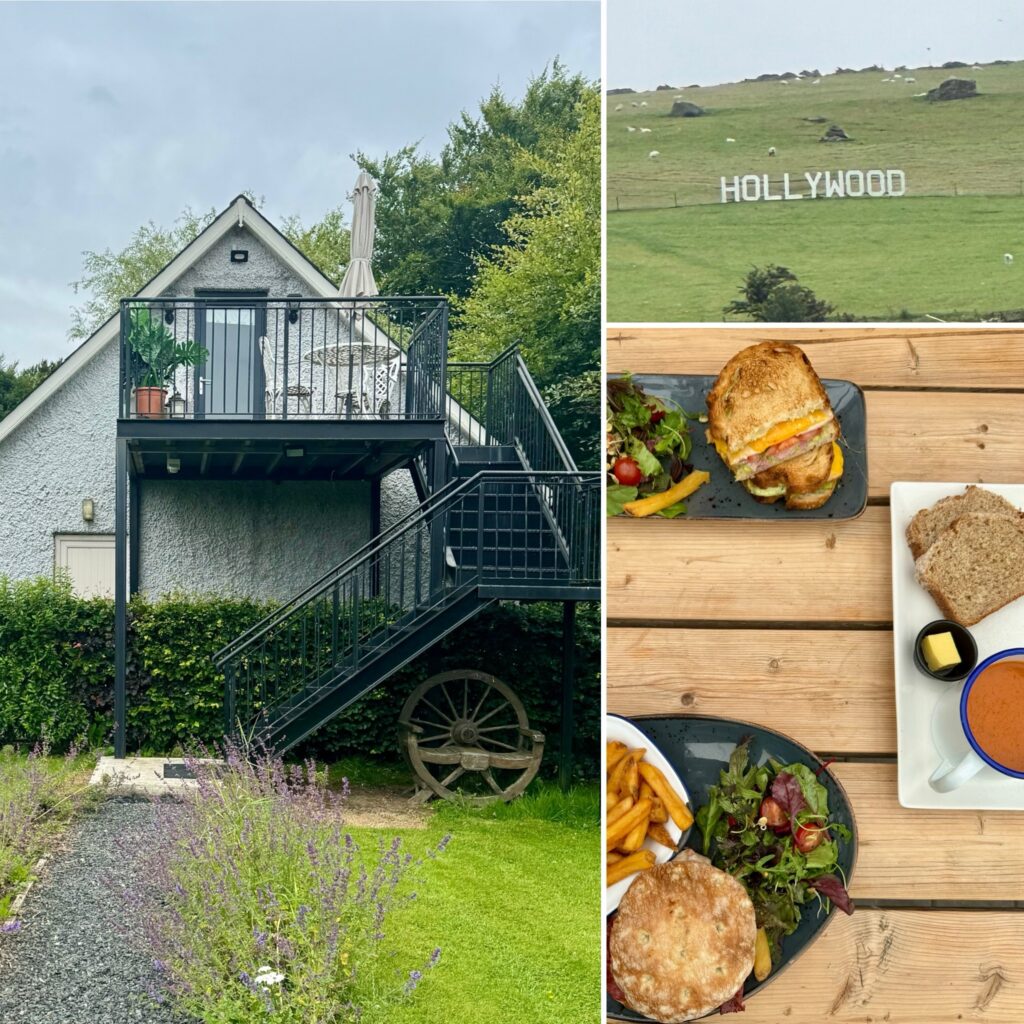
We didn’t see any filming but it was a beautiful village with two pubs and one delicious cafe. We used Hollywood as a base to visit a few places around the area.
Wicklow Gap

County Wicklow is a hilly upland area, featuring the Wicklow Mountains and a number of long mountain trails. The Wicklow Gap is a mountain pass on the St. Kevin’s Way trail, allowing one to stop and look over the rolling hills in both directions, before the trail continues onward to the Glendalough complex.
Glendalough

This monastic site dates back to St. Kevin’s settlement in the 500’s, although most of the remaining buildings are far newer than that (but still ancient). A thriving village in its day, the visitor center has a model of what the settlement may have looked like. The bulk of the site is just off the visitor center, but there are other buildings just a short walk away. And for the hikers, pilgrimage trails lead in multiple directions (including back to Hollywood).
While site entrance was included with the Heritage Card, site parking was not. But the fee for parking could be used toward the price of admission, essentially making parking free for those without passes, and undercutting the value of the Heritage Card. If the issue is that parking is a scarce resource, then everyone should be charged for it. Next time we would choose to park away from the site and take a trail in, which would also give us some of the experience of an ancient pilgrim.
National Botanic Gardens (Kilmacurragh)

We stopped for an afternoon guided walk around these lush gardens and arboretum, which are a satellite of the main National Botanic Gardens in Dublin. The area is outstanding for growing trees, and there are many valuable specimens that are called out during the walk. There are lush meadows, flowing water, and a pond that dates back to the property’s 7th Century use as a monastery.
This site was formerly a large country estate, complete with a large mansion, all dating to the 1700’s. The home currently lies in ruins but the OPW has plans to restore the home to its former glory and even has some of the original furnishings to put back on display. I would absolutely return for a visit to explore more of the gardens and the restored mansion.
Wicklow Brewery / Mickey Finn’s Pub (More on beer)
Every Irish pub we went to offered Guinness on tap. But the good beer selection often stopped there. We saw the same set of taps over and over again. Smithwick’s was often available, but beyond that was a mediocre set of lagers and ciders. Some were Irish. Heineken was also available, and oddly we saw taps for the Euro versions of Corona, Budweiser, and even Coors (served Euro-style in its own glass). According to Corey, “Other than some rare exceptions, the choice was usually Guinness, Smithwick’s, or any number of boring yellow lagers.”
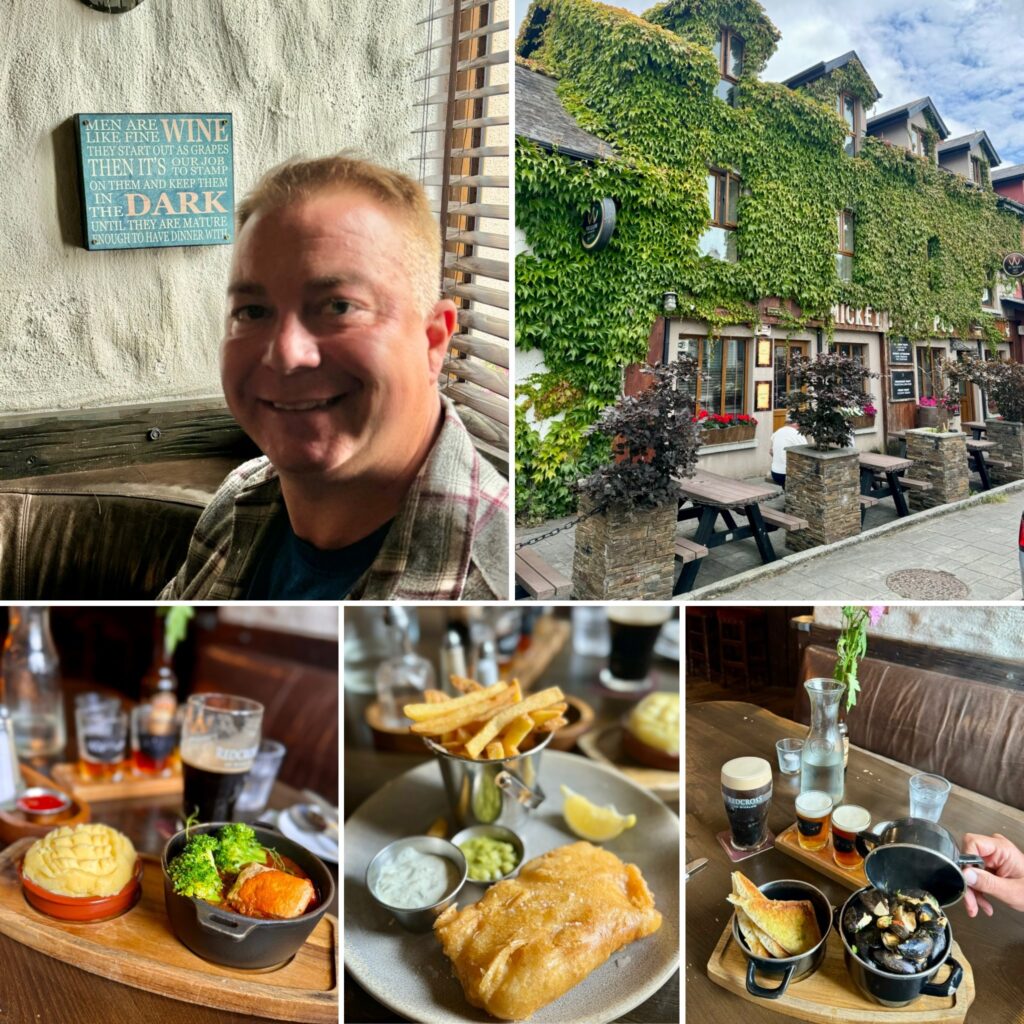
It was refreshing to find a craft brewery, especially one that also offered good food. Wicklow Brewery offers a range of beers, and we tried a pint of their Black 16 Stout (only available on draft) and sampled most of their remaining beers. Their Locknut IPA is made with kveik, a Norwegian strain of yeast that we had never tried before. The real standout for me was the food. The heaping bowl of mussels in a curry beer broth inspired me to recreate that dish at home!
Piper’s Stones (aka Athgreany Stone Circle)
There are many ancient and mystical sites across Ireland, but not all require admission tickets. Just down the road from our Hollywood Airbnb is a rock circle in the middle of a sheep pasture. We parked on the highway, made our way through the sheep door, and carefully walked around the fecal landmines. There on a hill lay 16 stones in a circle, with one outlier stone. Some of the stones are carved with art and what appear to be cupholders. There is a fairy tree nearby with cloth ribbons attached to it. It was just us and a handful of shy sheep grazing in the pasture and generally avoiding us. Why does this place exist? How did they move the rocks? It has the same unanswered questions as other prehistoric stone circles, but on the top of this hill, those questions can be contemplated without crowds or admission fees.
Dublin
Hollywood is only a 40-minute drive south of Dublin, so one day we drove to a park and ride and took the Luas tram into the city. It had been over a decade since I was last in the city and to be honest, it hadn’t changed much.

Dublin has generally retained its history, and there are so many wonderful places to see. We used the Rick Steves free audio guide tour (only available for iOS, not Android) and set out to see the sights!
The first part of the tour concentrated on the north side of the river and some of the more recent history. We concluded that portion by booking a guided tour of The Custom House. It’s an old administrative building with an explosive history. It was literally set on fire by the IRA in 1921 as part of the war for Irish independence, and the interior was only partially rebuilt as part of the restoration. The tour focuses on the details of the original exterior (dating to 1781), as well as the reason and planning for the day of the fire.

All that history had us starving so we walked south and sat for lunch at Featherblade Steak, a reasonably-priced steak restaurant with a few tables for sidewalk dining. We split a steak and their signature burger. Thankfully the sun was out, and we enjoyed dining right in the hustle and bustle of Dawson Street.
We were then ready for more history! The second half of the tour took place in the older streets of Dublin. We walked around St. Stephen’s Green, through the grounds of Trinity College, and eventually to Dublin Castle. (Student-run tours of Trinity College are available but not part of the OPW.)

Dublin Castle was built in the 1200’s by the Normans, although it has centuries of modifications after a major fire in 1684 and hundreds of years of use as a British government complex. Our tour started underground, where we could view the old castle walls and a site of Viking settlement next to the River Poddle. That river now travels underneath the castle, eventually flowing into the River Liffey.
We walked through Chapel Royal next to the castle. Unlocked with a comically-large key, this church is filled with much symbolism, and the walls and stained-glass feature dozens of coats-of-arms to acknowledge the various British governors of Ireland.
Next stop was the State Apartments, the exquisite interior rooms of the castle. They looked quite modern compared to the old stone castle walls we had just seen! Much of the furniture and decorations were originals. The sitting room was a long luxurious area filled with couches and mirrors. It’s where the ladies sat and it would totally be a place where I’d hang out too.
The throne room was next and unlike other places I’ve visited, the thrones were real! They were cordoned off but they are the authentic thrones used by the British monarchs when in Ireland. At that point in the day my feet were killing me, and I would have loved a five-minute break in that chair.

St. Patrick’s Hall is a large ballroom adorned with various chivalric flags and banners. Originally a place for dances and socials, it is now where the President of Ireland is inaugurated. The floorboards were mostly original and some creaked loudly with movement.
More than just the building, the State Apartments feature a ginormous collection of paintings and sculpture, which was hard to appreciate on the guided tour. There is a booklet explaining the art in the various rooms, and I would return for a self-guided tour of the castle just to spend time admiring the artwork.
But my feet were tired after a long day of walking, so we rested in the Castle Gardens. Surrounding the lawn are benches and nooks for private conversation and contemplation of the lush greenery.
The Rick Steves walking tour ended up in Temple Bar, where we grabbed tasty but expensive pints of Guinness at a bar with open windows and live music right next to the river. It was the perfect ending to a lovely day in Dublin.
Hurling and Catching Up with Friends

Barry was a colleague of mine during my last teaching contract in South Korea. We’ve kept in touch over the years and he really helped us plan our Ireland itinerary. As a professional tour guide and bus driver he really knows his stuff and freely shared his tips with us. True to Irish nature, he did his best to ensure we understood Ireland’s long and brutal history and magnificent marvels.
We spent a pleasant afternoon in Dublin with Barry and Insuhn drinking pints and watching the All-Ireland hurling finals at his uncle’s pub. Hurling is a fast-paced ball-and-stick game, and it was fun to immerse ourselves into this element of Irish culture. Barry taught us a lot about the game and we really enjoyed catching up.
Dublin was a bookend to our time in the south, as the next part of our trip took us north of the city to County Meath.
Navan, County Meath
For this part of the trip we stayed with Jazzy and her small companions, Maple & Hazel. The Ring of Kerry and other notable tourist sites are within a half-hour drive from Navan, which was great for making midday short trips while we took care of these animals.

Howth
We met up with nomad friends, Chris and Steve, for a cliff walk and lunch at this lovely little village near Dublin. Howth is accessible by car or Dublin’s DART train, which makes for a nice day trip.

We were blessed with gorgeous sunny weather, great for seaside walking. In addition to dozens of restaurants, this is also a great place to pick up fresh fish from the many shops in town. We picked up some Irish mussels and cooked them for dinner that evening in a curried beer broth.
We really enjoyed catching up with Chris and Steve. It had been almost a year since we last hung out at a Mariners game together. We originally met on the pickle ball courts of Westerdam on a repo cruise.
Trim Castle

This may have been my favorite castle in Ireland. With minimal changes over the years, this Norman architectural beauty was built in the 1200’s to service as a residence and seat of government for a local English Lord.
We joined a tour of the well-preserved keep. We climbed up the tight spiral staircases to the “roof” while touring the rooms in the castle along the way. The views of quaint Trim town and the verdant countryside were beautiful from the roof.

The most unusual thing I learned was about medieval ensuite toilets. Here’s a photo of one, which is sloped so the waste heads out of the building and down. But did you know they used to hang clothes about the toilet and stir up the pot below so that the rising ammonia would disinfect the clothing? That’s a gross and interesting fact!

Bective Abbey
This stone building is like a medieval jungle gym by the side of the road. Great for kids to run and climb and play hide-and-seek. The monastery buildings date to the 15th Century, and it was used as a mansion in the 17th Century. We decided to visit on a whim and I’m glad we did!
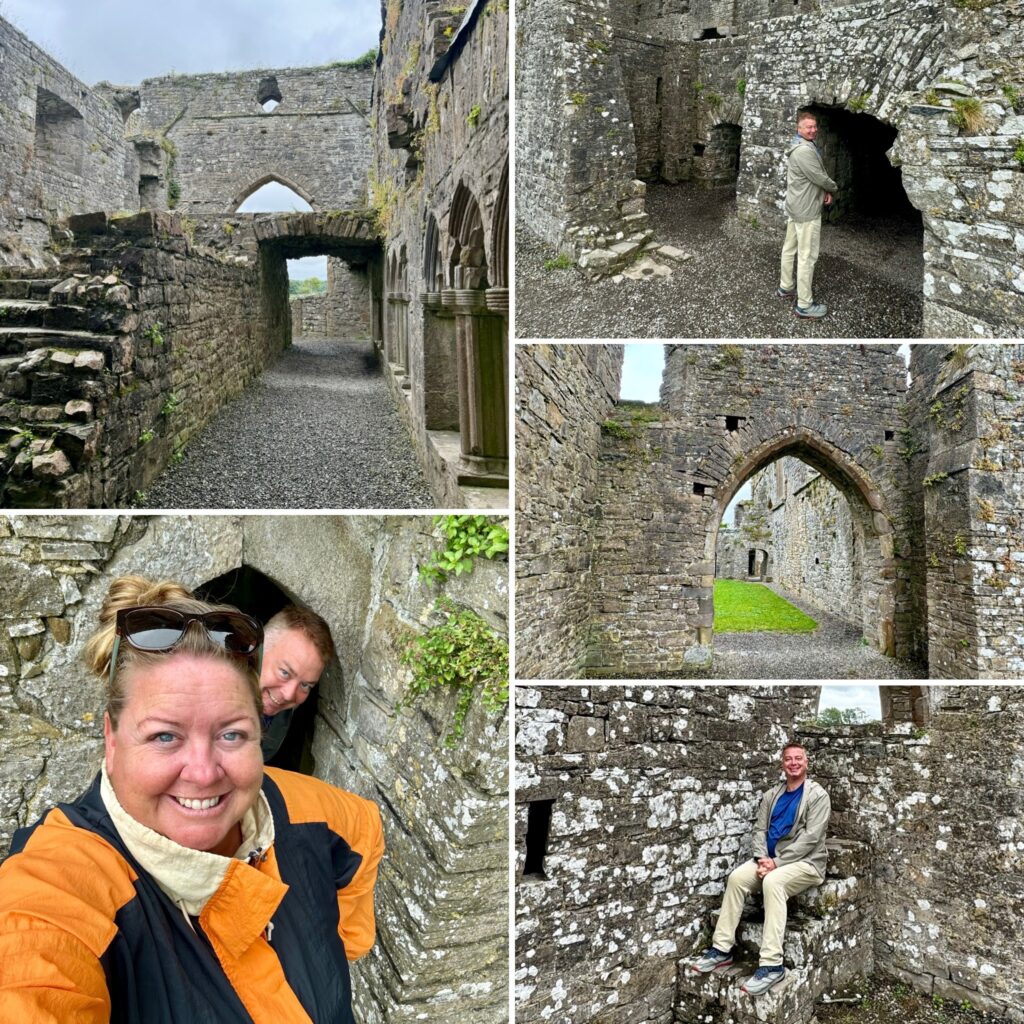
Tara Hill
Despite the cloudy and wet summer weather, we drove to Tara Hill for more sightseeing. It was late afternoon by this point so the weather and timing meant less crowds. We joined a free guided tour and I’m glad we did. Otherwise I’d have no idea what mounds of grass I was looking at!
From the visitor center we walked the grounds, taking the very path the Ancient Irish people would have taken during a procession or ceremony. Only these passage tombs remain as the great palaces and halls are no longer there.

Our guide provided a lot of context and stories about the area. If you haven’t been to Ireland, you might not be aware of the importance of The Hill of Tara. All of the old Irish roads lead here and it was the place that ancient kings of Ireland were ordained.
There is now a church onsite and a tall statue of Saint Patrick as he had even visited the prominent site.
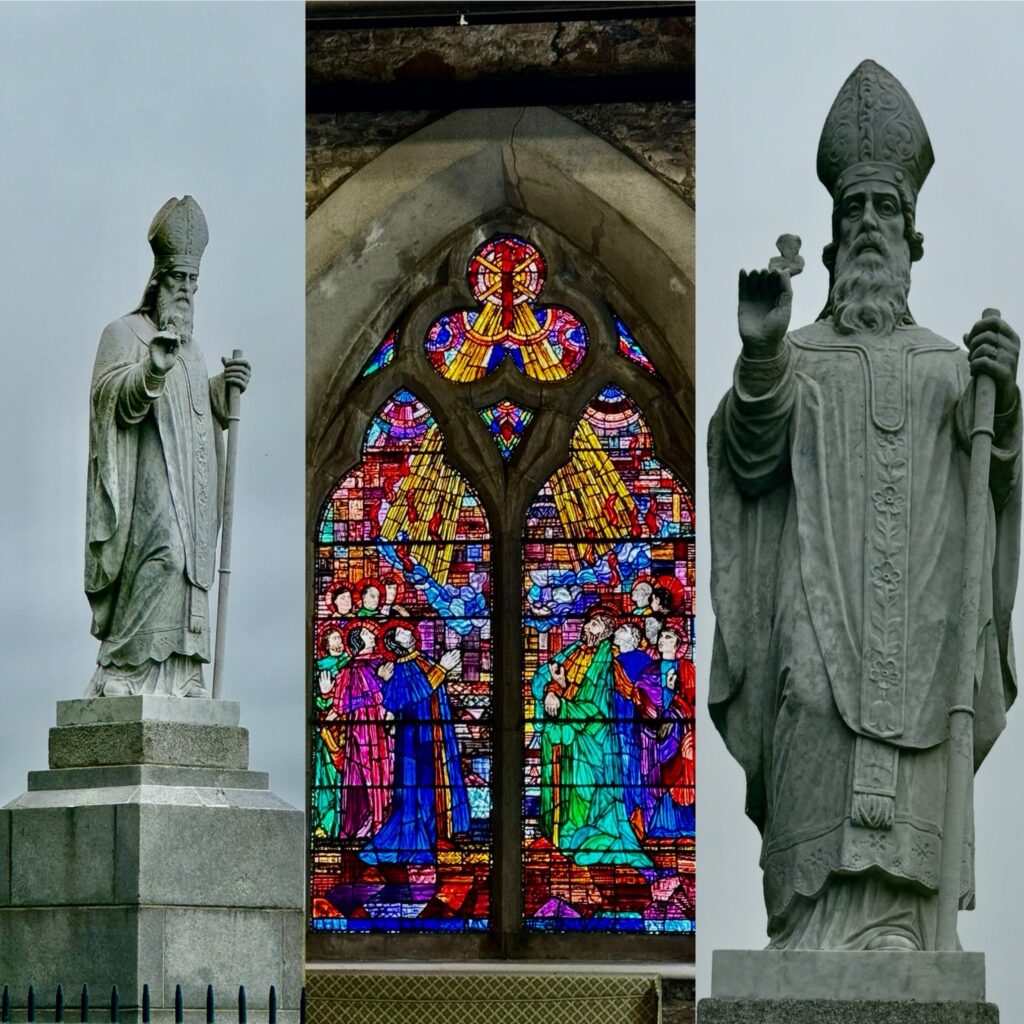
Newgrange and Bru Na Boinne Visitor Center
This part of Ireland is rich in Neolithic history, so the next day we made a trip to Bru Na Boinne. This area is also simply referred to by the name of its most famous passage tomb, Newgrange. Older than the pyramids of Giza, this old ceremonial tomb once held the remains of the dead. Newgrange is aligned so that on the winter solstice, the sun’s rays shine directly into the otherwise-dark inner chamber. More on that soon…
First, make sure to put Bru Na Boinne Visitor Center into the GPS. Everything starts at that point and there is no direct access to any of the sites. We saw multiple people on the wrong side of the river because they simply put Newgrange into their navigation systems.
Second, book tickets in advance because everything happens on a timed basis, and the experience does sell out. We booked the full three-hour experience, which is described as “BRÚ NA BÓINNE TOUR + NEWGRANGE CHAMBER: A guided tour to Knowth and Newgrange.” Tours to only one site are possible, but if you are already heading there, spend the extra hour to go to both sites.
The visitor center is a modern and multi-sensory experience. We showed up 30 minutes before our tour to allow us time to meander through the exhibits. They also allow another 30-45 minutes of leeway between the time on the tickets and the time that the buses left for Knowth.
In that time we learned about the prehistoric, pre-Celtic people of the area and what is known about their lives and their beliefs. We learned about the layout and history of the Bru Na Boinne area, including the history of the excavations. There is even a modern reconstruction of what it was like to enter a passage tomb for a ceremony.
After a short walk down a wooded trail, we boarded a bus to take us out to Knowth.

More than just a set of grassy hills, Knowth is a large collection of prehistoric sculpture. These enormous tombs are surrounded by boulders, carved with spirals and symbols by the people that found this area sacred. The site allows for full walking around the tombs, although there is no access to the interior. After explaining the significance of the site, some theories on the art, and some of the archeological debates about restoration, the tour continues to the top of the hill.
After that we were bussed to Newgrange. The tomb’s entrance has been slightly modified to allow for visitors to enter inside, but once inside the only changes are some structural supports, and the addition of lighting. We slowly crept in and through the tight, narrow passageway between rocks to get to the inside of this 5000-year old ceremonial site. While standing in the middle admiring the domed construction, small ceremonial chambers, and ancient rock carvings, the guide cut the lights and demonstrated a reenactment of what it is like on the winter solstice. On that day, the morning light shines into the tomb, which signaled that going forward, the days will be getting longer, and spring is on its way.

Bru Na Boinne and Newgrange were amazing!
County Mayo
Our last two days in Ireland were spent with friends in County Mayo, Michelle and Adrian. We enjoyed catching up since I had also not seen these these two since I left South Korea in 2012! I met Michelle during my first contract in South Korea, funny enough while we were both in Japan on a “visa run.” Adrian was a friend during my third contract and I actually introduced them to each other! The rest is history…

We spent the day in the touristy village of Westport and visiting nearby Bertra Beach. It was sunny in Westport and we enjoyed a nice day of shopping, lunch (and pints of beer), and walking around this cute town. Fitting for a sunny day, we stopped for a 99, which is a cone of whipped-ice-cream (soft serve) with a “flake,” a piece of flaky, crumbly chocolate. This hit the spot, although I still prefer Italian gelato.
Bertra Beach had driving wind and rain coming off the coast. But we can check the box that we saw the Atlantic Coast of Ireland! And it was a great day spent with old friends. I am so glad they hosted us and that we got to spend time catching up, reminiscing of old stories, meeting their gorgeous daughter, and playing games. It filled my heart to end a trip down memory lane.
Rental Car Warning
Our final day in Ireland started around 5 AM with a long drive from County Mayo to the rental car return at Dublin Airport. Ireland falls in with Jamaica and Israel as countries that are not typically covered by credit card rental car protections. Irish country roads are narrow, with stone walls on either side, and the locals drive fast. The advice we saw was to rent from an Irish website to make sure that the rental includes the appropriate liability insurance, which we did. But we would add to be extra diligent in the rental car inspection. Our pre-rental inspection took place in a dark garage at Dublin Airport, with the cars parked so close together that it was difficult to walk between them. While we took a video of the car and noted existing damage, the lower areas of the vehicle are dark and blurry in the video. On the other hand, the post-rental inspection takes place outdoors, and in the light the employee saw and charged us for a scuff on a tire, directly below some already-existing damage.
Don’t get dinged for damage that you did not cause: if you rent a car in Ireland, take more videos and photos than you think you possibly need. Focus especially on the tires and rims, any glass damage, and the lower portion of the bumpers and side panels.
Conclusion
We enjoyed our month driving around Ireland, using the OPW Heritage Card to see many amazing sights. This would have been a difficult journey without renting a car, as mass-transit and rideshare quickly dissipate outside of the Greater Dublin area. While we took a grand Irish tour, we hardly touched the western Atlantic coast, and every county has something to offer tourists. The constant threat of rain put a literal damper on some of our plans: beach walks or ruins exploration are much nicer when the weather is nicer. But that seems unavoidable – even in July!
Barry, Insuhn, Adrian, Michelle: we loved spending time with you and appreciate all that you did to make us feel welcome in Ireland! Slainte!
Next we head to Las Vegas for some quick sunshine before heading to Manchester in the United Kingdom!
